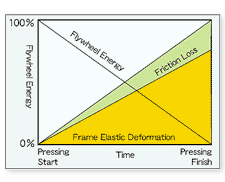Energy Consumption in the Screw Press
The flywheel energy is consumed one hundred percent every press operation cycle as a form of plastic deformation, friction loss and frame elastic deformation. Putting aside considerable same amount of friction loss in various screws, the flywheel energy is consumed mostly for product's plastic deformation and none in frame's deformation when products are mild and bulky. In other word, the frame bears very little load.

Flywheel Energy Consumption
(without Work Piece)
Flywheel Energy Consumption
(with Work Piece)
Adversely, the flywheel energy is mostly consumed in the frame deformation when the products are difficult to deform with tough and thin material. That causes relatively large frame expansion. The screw press has no mechanical lower-dead-point and this avails to strike upper and lower tools. The flywheel energy in this status is completely consumed on the elastic deformation for such as the frame.
Ideally, the flywheel energy should be used mostly for products plastic deformation from the viewpoint of energy efficiency. Therefore, it is necessary to enclose the tools as much as possible to allow avoiding the edge burrs hit because the edge burrs are thin and almost that makes similar to strike tools each other.
On the other hand, however, you can't forget about a big advantage of the screw press when you stamp the thin plate, too. Stamping the thin plate with mechanical press that has lower-dead-point is very difficult to form products from the point of frame deformation. Mechanical and hydraulic presses require large press capacity to form the thin plate. Sometimes, for example, a press operation with 1000kN on the screw press needs three more times or five more times of large machine in mechanical press or hydraulic press respectively.



















